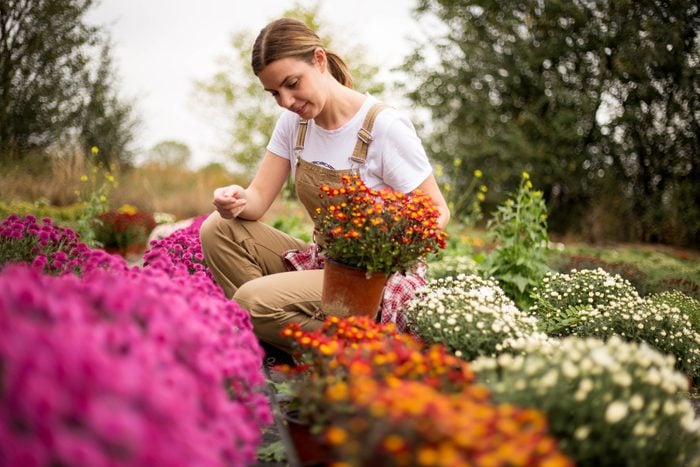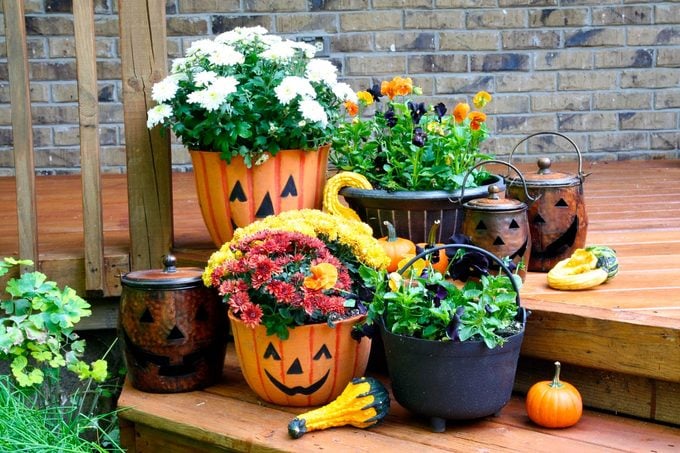Save Money and Get More Out of Your Fall Flower Planters
Updated: Oct. 03, 2023

Perennials can bloom in your fall flower planters now and be part of your perennial garden next spring.
When fall rolls around, the containers you planted last spring usually look worn out. They’ve worked hard all summer to make your front entrance or patio look inviting. Now it’s time to bring them back to life.
At this time of year, my local garden center puts perennials on sale alongside full-priced mums, pumpkins and cornstalks. These perennials can fill in any gaps in your summer containers to extend what’s left of the season.
I recently talked with Barbara Pierson, nursery manager and spokesperson at White Flower Farm of Litchfield, Connecticut, about saving money with perennials in fall planters. “Fall containers using perennials for color and texture are increasing in popularity,” says Pierson.
Instead of buying new annuals you’ll toss on the compost pile in a couple of months, choose perennials you can enjoy now and remove later to plant right into your perennial gardens.
On This Page
How To Save Money With Perennials
Follow our advice, and you’ll save money and enhance your perennial gardens.
Divide large perennials
Slide a large perennial plant out of its nursery pot and gently pull apart the root ball into three plants. You can also divide a perennial by using a clean scissors or garden shears to slice through the root ball.
Each plant can go in a different container, or a window box as part of an arrangement. That’s three fall-blooming plants for the price of one!
Transplant perennials into the garden
The perennials in your fall planters can be moved to the perennial garden at the end of the season. Remove spent blooms as they fade while the perennials are in the planters. They will go through the blooming cycle, then be ready for relocation.
“I usually do this in my garden [in Connecticut] prior to Thanksgiving, so they have time to root in before the ground is frozen,” Pierson says. Here’s what she recommends:
- Dig carefully around each perennial and lift it out of the planter with as much root mass as possible.
- Plant the same day, keeping the depth the same as in the planter so the roots and top growth are the same level.
- Water the plants once a week for a few weeks while the plants root in. If you receive rain or soil stays moist, skip this step.
- Faded flowers can be cut, but not the foliage. Let that die down naturally
Expert Picks for Perennials for Fall Planters

“There are a variety of plants like anemone and asters that flower in the fall,” Pierson says. “Others such as grasses and sedum also bloom and have interesting fall color as the temps drop.”
Here are Pierson’s top choices for perennials that do well in fall containers:
Flowers
- Anemone, ‘Curtain Call Deep Rose’: Shorter, semi-double rosy pink blooms with dark green leaves.
- Aster (now Symphyotrichum), ‘Woods Blue’: A reliable compact aster, with light-blue flowers.
- Chrysanthemum, ‘Pumpkin Igloo’: Hardy, pumpkin-colored flowers and fully hardy.
Ferns
- `Dryopteris Brilliance’: For festive fall color and texture.
Grasses
- Hakonechloa, ‘Aureola’: Striped yellow foliage that pairs well with other plantings. It also works well as a garden grass, low and mounding with bright color in part shade to shade.
- Heuchera, ‘Obsidian’: Rich, dark color that creates contrast. In the garden, it works well as an edging plant.
- Sedum, ‘Angelina’: Let it drape down and then fill and creep around other plants in the garden.
Another Thrifty Tip: Use Free, Natural Decorations
For the most beautiful and budget-friendly fall planters, take advantage of what you have in and around the yard. Cut branches with colored leaves or berries. Use the trimmings from your fall garden cleanup when you shape bushes and trees. Branches without foliage can add a natural touch to a planter.
Branches can be spiked into the soil for filler in planters or placed horizontally in window boxes to create a bough effect around plants and gourds.
